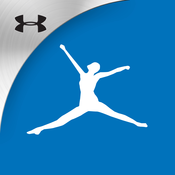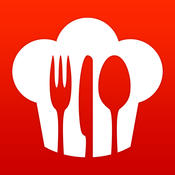The freshmen fifteen is a very real phenomenon that is present on many college campuses. A big reason for some people putting on weight in their freshmen year of college is because of poor nutrition. Often students are eating comfort foods that are high in fat and have too many calories. My campaign is directed at trying to raise awareness of this issue and present ways in which a change could be made. In this blog post I will recommend three apps that could be used to make a change and help freshmen monitor their own diet and food choices so that can avoid putting on any unwanted weight in their first year of college
App #1
The first app that I would like to recommend is the Calorie Counter & Diet Tracker by MyFitnessPal.com. This app is considered to be one of the fastest and easiest calorie counters out, here is why.
Platforms: This app is available on iOS, Windows, and Android
Ratings: Current version – 4/5 stars from 1,1256 ratings
All versions – 4.5/5 stars from 451,495 ratings

Price: The app is free, although it does offer in-app purchases. The top purchases are MyFitnessPal Premium, which comes at $9.99 per month, or at $49.99 per year. Becoming a premium member allows you to have an add free experience and also adds some neat features such as food analysis, exercise calorie settings, and exclusive articles and tips that are only provided to premium members.
Description/Features/Function: This app is built to enable the user to be able to keep track of their diet through counting calories. MyFitnessPal has a database of over 5 million different food items to ensure accuracy. The app also has a barcode scanner that allows the user to import information instantly through scanning the item. It also has a built-in step tracker that will help user keep track of their exercise. Another cool feature that the app has, is the recipe importer, which lets the user import and track any recipe from the web with a touch of a button. With all of this information, MyFitnessPal is able to track total calories consumed, as well as fat, protein, carbs, sugar, and fiber separately. MyFitnessPal is also able to connect with over 50 other health and nutrition apps including Fitbit, Garmin, Strava, Healthkit and many more. This enables MyFitnessPal to be more accurate in tracking the user’s diet and exercise information.
It is easy to see that this app offers many features and functions that might help an individual, but how does it help with my goal of fighting the freshmen fifteen? Simple, knowledge is power. If students are able to see how many calories they are eating then they might be able to modify their own diets to their own specific needs. As the app is able to track specific nutrients within food items, then it will be easier for students to see how much fat/carbs/sugar are in an item and then make a more informed decision as weather or not to eat it. With students making more informed decisions they will be more likely to eat foods with less fat and keep their calorie counts within a normal range, meaning they won’t be gaining any unwanted weight.
As you can see from the screenshots MyFitnessPal is easy to use. Navigation through the various features is smooth and seamless, which makes it easy and convenient to track your food items throughout the day.



App #2
The second app that I would like to recommend is the Yum-Yum app developed by IGGY Media LTD. Yum-Yum is a fantastic app for anyone looking to learn fresh recipes with ease. Lets take a look at what the app has to offer
Platforms: This app is only available with iOS and is compatible with both iPhones and iPads with iOS 7.0 or later
Ratings: Current Version: 5/5 stars from 13 ratings
All Versions: 4.5/5 stars from 109 ratings

Price: The app is free, although it does come with in app purchases. The most expensive upgrade available is the premium version of the app, which allows you to experience all of the current features without being distracted by any advertisements. In addition to the 1000+ recipes that come with the app, more can be purchased for as little as $1.99 (pasta, chicken, breakfast, and salad recipes) or as much as $9.99 (additional recipes in all categories).
Description/Features/Function: This app is built to enable the user to be able to access thousands of recipes that have been developed and perfected by chefs from some of Europe’s finest dining restaurants. Each recipe that is in the app is accompanied by step-by-step instructions. All of the instructions are enhanced by a photograph, to help ensure that there is no confusion for the user. Yum-Yum also provides nutritional facts for each recipe to ensure that the user knows exactly what they are making in terms of fat, protein, carbs, and total calories. Another neat feature of the Yum-Yum app is the advanced grocery list. The advanced grocery list allows you to keep track of exactly what you need for each meal so that impulsive spending is limited. You can also automatically push all of the ingredients of a recipe to your grocery list so that nothing is missed.
Clearly this app has many cool features to help people with their home cooking, but Yum-Yum recipes also has the potential to help freshmen on college campuses across the country with their own diets and nutrition. If students used the app then they might be able to make meals for themselves rather than dining out, which often means that the meals they will be making will probably have less fat and more quality calories. Since the app has many recipes for any occasion, freshmen would be able to have variety in their diet and will be more likely to stick with making their own meals. Also if the app was to be paired with the Calorie Counter & Diet Tracker by MyFitnessPal.com (see above for description) then students would also be able to be more accurate in keeping track of how many calories they are consuming on a day to day basis. With this kind of knowledge, students would be much more likely to keep of any unwanted weight and fight of the freshmen fifteen.
The app is very easy to use as you can see from the screenshots below. Recipes are divided into different categories to make for easy searching, and each feature of the app runs smoothly and is self-explanatory.



App #3
The third and final app that I would like to recommend is the HealthyOut app developed by HealthyOut. HealthyOut is a great app for anyone wishing to find healthy meals while on the go. Lets take a look
Platforms: The app is available on both Android and iOS
Ratings: Current Version – No ratings
All Versions – 4.5/5 stars from 1586 ratings

Price: The app is completely free and has no in app purchases available.
Description/Features/Function: This app is designed to help users find healthy meals from restaurants and prepared grocery items nearest to your location. The app is able to recognize meals in restaurants in over 500 cities across the country. HealhyOut’s definition of a healthy meal is one that has both half of the fat and half of the calories of an average American restaurant meal. The app uses your current street address and zip code to find food items that are nearby. Once the search is done you can add a variety of filters to find foo items specific to your own needs. Filters include a number of calories, specific ingredients, special diets such vegetarian and many more. Once you find a meal that fits your needs the app will offer detailed nutritional information about the food item, such as grams of fat and total calories. The app also suggests any modifications that can be made to make the meal have less calories or less fat.
Clearly, the app can give you the confidence that eating out doesn’t have to be all grease and fat, but how can HealthyOut help in the fight against the freshmen fifteen? A lot of the time college students across the country are very busy and don’t have time to cook every meal for themselves and must order food to be delivered. By using this app, students would be able to find meals and food items that would be healthy for them and not put them in danger of putting on any unwanted weight. If this app was combined with the MyFitnessPal app then students would still be able to keep track of their calories whilst eating out. This would further help them in trying to make better food choices and fight the freshmen fifteen.
Below are screenshots of the various features that the app offers. As you search through the app, each feature is presented in a logical order that makes the app very easy to use.



I sincerely hope that these apps are able to help you and your way to becoming a better eater and having healthier eating habits. We all know what the benefits of eating healthy are, so use these apps to your advantage and reap the rewards,
Fight The Freshmen Fifteen,
Stay Tuned!










